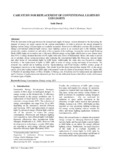Please use this identifier to cite or link to this item:
https://elibrary.khec.edu.np:8080/handle/123456789/181Full metadata record
| DC Field | Value | Language |
|---|---|---|
| dc.contributor.author | Duwal, Indu | - |
| dc.date.accessioned | 2022-05-02T11:18:06Z | - |
| dc.date.available | 2022-05-02T11:18:06Z | - |
| dc.date.issued | 2019-11 | - |
| dc.identifier.issn | 2091—1475 (Print) | - |
| dc.identifier.issn | 2645-8518 (Online) | - |
| dc.identifier.uri | https://doi.org/10.3126/jsce.v7i0.26789 | - |
| dc.description.abstract | With the increment in the gap between the demand and supply of energy, various alternatives for decreasing the demand of energy are major concern for the various stakeholders. In order to decrease the energy demand by lighting various energy efficient lights are available in market. However it is difficult to convince the residents to change conventional artificial light sources, since lighting system is an essential part in the building which ensures the comfort, productivity and safety of the occupants in the buildings. Among the various Light Emitting Diode (LED) lights are termed as one of the most efficient energy saving lights which aims to save almost more than 50 % of energy demand than that of CFL lights with same power of illumination. Hence, this study is carried out to calculate energy saving percentage after replacing the conventional lights like florescent, mercury lights and other forms of conventional lights by LED lights. Additionally the study also was focused to evaluate feasibility of the replacement of lights by LED lights in terms of energy saving and return of investment. The research was carried out in building used by Agrotechnology and Food Science (AFSG) science group of Wageningen University in the Netherlands. The results from the study showed that almost 50% of the energy can be saved after replacement by LED lights with around 5 years for return of investment. However, factors like 1) Number of operating hours, 2) Price of lights, 3) Energy cost, 4) Labour cost for replacement and adjustment and 5) Number of replacement and adjustment per hour are the influential features that effects in the performance of various types of lights. | en_US |
| dc.language.iso | en | en_US |
| dc.subject | Energy Consumptions, Energy saving, LED | en_US |
| dc.title | CASE STUDY FOR REPLACEMENT OF CONVENTIONAL LIGHTS BY LED LIGHTS | en_US |
| Appears in Collections: | Journal of Science and Engineering Vol.7 | |
Files in This Item:
| File | Description | Size | Format | |
|---|---|---|---|---|
| 6_Indu_Duwal.pdf | 1 MB | Adobe PDF |  View/Open |
Items in DSpace are protected by copyright, with all rights reserved, unless otherwise indicated.
